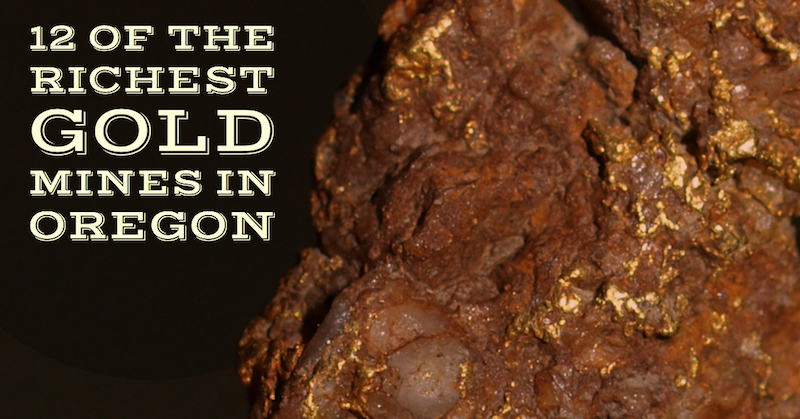
The first gold discoveries in Oregon followed not long after the California Gold Rush. Miners ventured north across the border and found that many of the creeks and rivers in southern Oregon also contained gold. Almost a decade later, gold was found in the Blue Mountains of Eastern Oregon, which ended up being the richest mining area in Oregon.
The Oregon gold rush started in 1850, when Josephine Creek, on the Illinois River became the site of the state’s first significant gold discovery. In northeast Oregon, several discoveries put the region on a growth trajectory. In 1861 Henry Griffin discovered a gold nugget in Griffin Gulch just south of Baker City and then in 1862, gold was discovered in Cracker Creek and Sumpter Valley. Most of the gold produced in Oregon is extracted in the Blue Mountains in an area that straddles Grant and Baker Counties. Between 1860 and 1960 the state produced more than $130 million in gold.
Below are 12 of the top gold mining regions in Oregon. These places account for much of the states total gold production, and are still good places to go prospecting.
1. Canyon City
This was the site that most consider to be the single richest placer deposit in Oregon. Canyon City is a few miles south of the town of John Day. Reports of gravels paying as much as $500 per yard were reported when the first gold was mined here. The richest area was at a placer called Whiskey Gulch, but rich gravels were found in Canyon Creek and all down the John Day Valley.
The discovery of gold in Canyon Creek in 1882 led to the rapid growth of the town to become the county seat for Grant County two years later. Between 1862 and 1902, Canyon Creek produced more than 800,000 ounces of gold. The river, which flows through the rustic city with a deep history, continues to attract prospectors trying their luck at gold panning.
2. Burnt River Placers
The Burnt River is one of Eastern Oregon’s longest gold bearing rivers. The richest stretch runs through the narrow, winding Burnt River Canyon to the west of Durkee, then all the way downstream to where it enters Brownlee Reservoir. There is plenty of gold in the current river channel, but the richest spots are actually in the ancient river deposits that follow well above the current water level.
Numerous gulches near Weatherby including the Raven placers just below the Gold Ridge mine as well as the river’s tributaries – Sisley Creek and Chicken Creek – were also very productive. A ladder-and-bucket chain type dredge was deployed at Weatherby, where the canyon widens to accommodate such a big machine.
3. Cornucopia Mines
The town of Cornucopia is on the southern end of the Wallowa Mountains. The rich gold ores hidden within the mountains here are believed to be some of the richest in the West. During its peak there were hundreds of men working the underground tunnels to extract the ores. Various factors such as the Great Depression and other challenges eventually led to the mine closure, but there is still abundant gold here.
Gold was first prospected in Cornucopia in 1880 before the first lode deposit was discovered in 1884 by Lon Simmon. When the miners started using improved metallurgy, the Cornucopia mines rose to become the sixth largest gold mining complex in the United States.
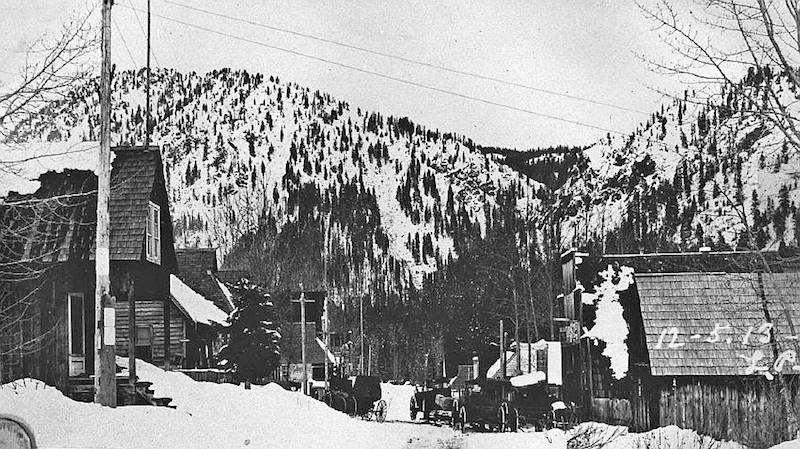
Downtown Cornucopia during the late 1800’s. The high elevation made for hard living during the winter months.
4. Galice Mines
The first gold mining in the area was in 1854 on Galice Creek. The mines in the Galice District extended north and west of the town of Galice in northern Josephine County. Notable mines include the Old Channel mine which was the largest hydraulic mine in the state.
The mines of Galice were some of the of the largest in this part of Oregon. Placers were found in Galice Creek and nearby Rogue River, but the richest source of gold here was actually from an ancient river channel high above the existing water. Huge hydraulic monitors were used to wash away the ancient cemented gravels and release the gold within. This was a huge mining operation, and there are still miners actively working in this area today.
5. Sumpter Valley Placers
For decades, the Sumpter Valley Gold Dredge dig the gravels of the Powder River in Eastern Oregon. Before that, it was miners searching through the gravels with picks and shovels to unearth the noble gold hidden beneath. The Sumpter Dredge is still there, and while not active any longer it is now a State Park where people can enter and see the inner workings of this monster machine.
Gold was discovered in the Blue Mountains in 1862 and the nearby Sumpter Valley was awash with gold that drained from the mountains. Experienced prospectors from the California Gold Rush descended on the valley and quickly devised ways to mine on a large scale using a dredge. There were three gold dredges working in this valley from 1913 to 1954. More than 2,500 acres of farmland were dug up by these monsters in an effort that produced more than $10 million worth of gold.
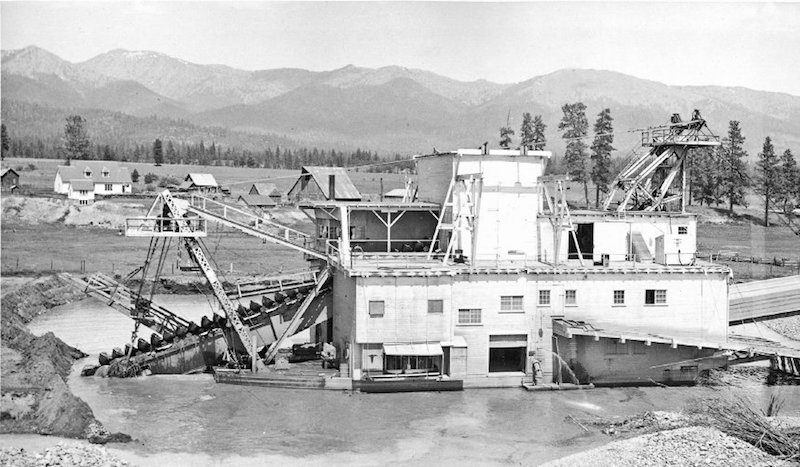
The Sumpter Gold Dredge hard at work churning up the deep gravels of the Powder River. Most of the gold found around Sumpter is credited to the big dredges that worked in the valley.
6. Jacksonville Diggings
The town of Jacksonville is a short distance from Medford. Just a few years after the start of the Gold Rush in California, gold was found on Jackson Creek. The town exploded and thousands of miners ventured north to Oregon. Additional placer discoveries were made at Walker Creek and Poorman Gulch. Hydraulic mines scoured the surrounding hillsides to release the gold into the miners sluice boxes.
The Rich Gulch placer deposit near Daisy Creek was the site of the first gold discovery in Jacksonville in 1851. Many placer deposits were subsequently mined in the vicinity and more prospectors settled and grew the city rapidly.
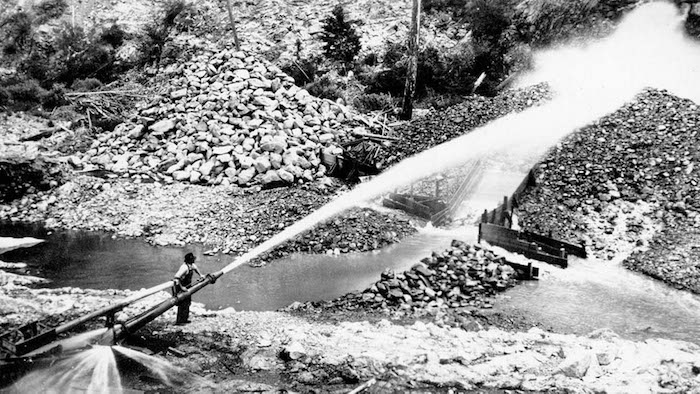
Hydraulic miners scoured the hillsides with high-pressure water and released gold hidden within the gravels.
7. Virtue Mine
Just east of Baker City is Oregon’s richest gold mine. The Virtue Mine recovered more gold than any single hard rock mine in the state. It was surrounded by several others rich mines n the Virtue Hills, including the White Swan Mine and the Con-Virginia Mine. It started operations in 1862 and produced gold and other metals such as silver, copper and tungsten. The total gold production was worth more than $2 million.
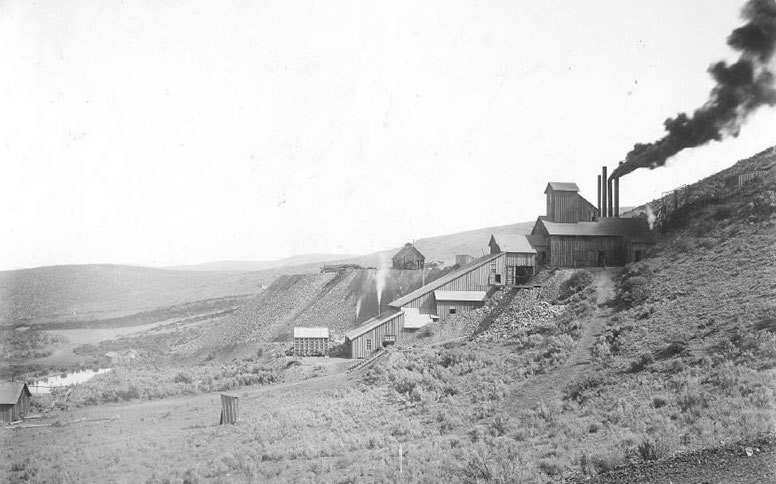
The Virtue Mine is located in the dry hills just east of Baker City.
8. Greenhorn Mines
The mines at Greenhorn are part of the rich Eastern Oregon gold belt. The townsite of Greenhorn is located high on a mountain, and there are many rich mines here. A few different creeks in the area contain placer gold, but this was primarily a hard rock mining district that extracted a wide variety of minerals.
The discovery of gold in 1865 at Robinsonville, about five miles to the north of Greenhorn, gave impetus to the growth of the town. In the years that followed more than 80 gold mines operated in the Greenhorn District. Notable mines such as the Bonanza mine and Red Boy mine contributed to a total gold production of more than $3 million.
9. Gold Beach
The gold strike at Gold Beach was one of the more interesting ones in Oregon’s history, because the gold here is literally found within the sands of the beach. Surprisingly, there is gold all throughout the sands in Southern Oregon. The source of this gold is from the Rogue River and more generally from the rich gold belt of Southwest Oregon. It was challenging to mine these sands profitably, but modern equipment makes this fine gold very interesting today.
Gold was discovered near the mouth of the Rogue River in 1852 by placer miners on the beach. Gold mining operations expanded upriver attracting thousands of miners. The beach town, which was originally known as Ellensburg changed its name to Gold Beach and later became the county seat.
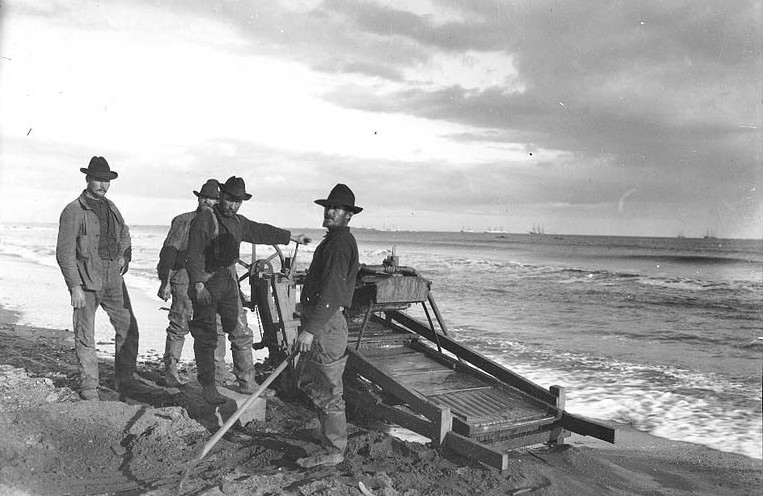
The first miners to arrive at Gold Beach were blown away by the amount of gold that was hidden amongst the sand. They would locate the black sand concentrations and use pans, sluices, and rocker boxes to capture the tiny gold particles.
10. Rogue River Placers
The mighty Rogue River is the main drainage that empties the Southern Oregon gold country. As such, it is full of gold and was mined heavily back in the early days. Even now there is lots of gold to be recovered. A lot of this river now has limits on mining preventing the use of large equipment. Even with just the use of a gold pan, a hard worker can find a lot of gold here.
The numerous tributaries of Rogue River have excellent locations which have been productive. They include Bear Creek, Applegate River, Illinois River, Sardine Creek, Evans Creek and Grave Creek. Specific areas for gold prospectors to look out for are Grants Pass, Gold Hill, Gold Nugget Waysides and within Hellgate Recreation Area.
11. Althouse Creek
This creek is named after a Mr. Althouse, the first person to find gold in the stream in 1852. The hills surrounding Althouse Creek contain numerous lode deposits that feed the creek such as the Briggs Pocket Mine.
Althouse Creek is in far southern Oregon and drains the high country right at the California border. This creek holds the distinction of producing the largest gold nuggets in the states history. In 1859 Mattie Collins retrieved a gold nugget weighing 17 pounds from the North Fork of Althouse Creek. He cashed it for a whopping $3500 at the time. Many people think that the Armstrong Nugget is the biggest, but Althouse Creek an the Illinois River produces some that were much larger that were smelted down.
12. Gold Hill Pocket
Southern Oregon is known for it’s rich “pocket gold.” The single largest pocket gold discovery was at Gold Hill. Some rumor that there was as much as 1/4 million dollars worth of gold found in a small area at Gold Hill. There are still hidden “pockets” waiting to be discovered in Oregon. Miners still find them from time to time, often recovering several pounds of gold or more.
In 1860, Thomas Chavner and his partners discovered some gold-bearing quartz near his farm and immediately filed mining claims. They extracted $700,000 worth of gold attracting prospectors who swarmed the area and soon the hills were filled with mines. The pocket lode discovered by Chavner and company was depleted in just eight months but the area grew into the town of Gold Hill.
Next: Oregon’s Largest Gold Nugget on Public Display

